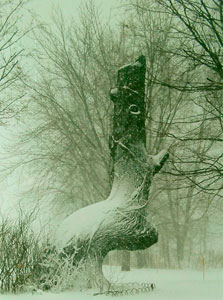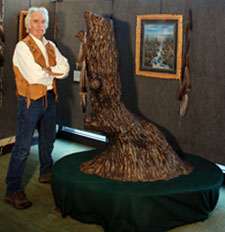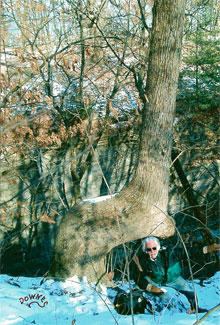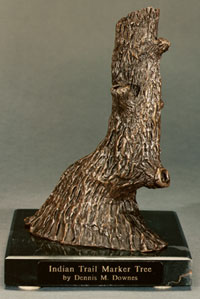Long ago this beautiful land surrounding us was home to a different way of life, a different system of beliefs, one based on harmony between people and the earth. Hidden within the forests of the Great Lakes Region and outlying areas stood living examples of a relationship between man and nature. This area, occupied by the ancient ones, left behind the legacy of the Trail Marker Trees!
Try to think of the Trail Marker Trees not as marking the entire route to an area but rather as the exit signs for specific areas of interest or necessity to the Native Americans. Remember, they were on foot; a simple mistake could have a serious outcome. Mistaking a bent, deformed or diseased tree as a true Trail Marker Tree would have caused serious problems leading to extended travel times or worse.
Chosen as saplings, these culture landmarks have endured centuries to specify direction or location. For their strength to withstand both time and the elements, mostly hardwoods were used, specifically white oak, our State Tree in Illinois, and occasionally elm and other hardwoods. The young tree was bent in an arch and fastened to the ground by vines or rawhide or tied across a yolk.
This trained the tree to grow parallel to the earth. The limbs facing downward soon shriveled and died and one of the branches shooting skyward from the top of the arched trunk was selected. This branch was nurtured by the Native Americans to become the new trunk. After several years the vine or rawhide was removed as well as the remaining portion of the original trunk that extended past the new trunk. This left the tree as if it were pointing the way and gave it its distinct shape. Its singular branch now gave the tree a triangular shape very distinctive from the full, round crown of the normal oak tree. This practice left the new main trunk of the Trail Marker Tree noticeably smaller, approximately one-third of the diameter of the original bent trunk - another unmistakable characteristic of the Trail Marker Tree.
Unlike some parts of the country, the Great Lakes Region has extensive cloud cover much of the time eliminating the use of stars for navigation. There are also few hills or peaks high enough to be used as guides, making the Trail Marker Trees even more of a necessity in our area. Some Trail Marker Trees directed the indigenous people to fresh water springs, mineral deposits, stone quarries, caves or natural shelters. Others simply pointed out the safest place to cross a river or to keep you along the top of a ridge avoiding the marshy lowlands. Their presence here provides a window into the cultural past of the people of the Great Lakes landscape.
This is a window through which artist Dennis M. Downes has crawled since he was a boy. The tales told by older gentlemen to him regarding the different uses of the Trail Marker Trees would ultimately change the direction of his own life. His natural tendency towards exploration has led him from libraries and museums to the fields. "His research into this area and knowledge of it is unique: I know of no other person who has so systematically searched out references to these trees and spent such an extraordinary amount of time on the study of the Trail Marker Trees." Downes' study is now in its third decade. Ann McMullen, Ph.D., Curator at the Smithsonian, Washington, D.C. National Museum of the American Indian.
Dennis M. Downes has taken his interest and study of the Trail Marker Tree to researching it and visiting actual sites in over 20 states over the course of the last 25 years. He also created a bronze sculpture of the Trail Marker Tree and used this piece at over 100 public and private shows. He has given lectures and distributed thousands of informational papers throughout the US as well as Canada and the United Kingdom to help teach the public the story of the Trail Marker Trees. As a result of this, Mr. Downes has a 16 foot sculpture of the Trail Marker Tree gracing the entrance to the Lake County Discovery Museum and a documentary of the Trail Marker Tree produced in 2005. "This is one of those rare occasions when the marriage of reverence for the past and artistic form occur to produce a truly important work. As a means of preservation, he has brought forth the histories of these great cultural landmarks and reconnected us with an understanding of those that were here before us." Dr. Harry Spell, Historian and Foundry Owner.
"Much like the petroglyphs of the Southwest, we all agree the Native Americans created them, but, not even the Native Americans of today can agree on which tribe started them or the true meaning of the symbols," as stated by Richard Harris, author of Rock Art Symbols. Trail Marker Tree origins have similar problems, while we all agree that the trees were shaped by Native Americans, it is impossible to give credit to a single tribe since the Trail Trees were located throughout the Great Lakes Region as well as to the west and the southeast. As a result of this, there could be subtle differences in the types of trees, techniques of shaping them and their meanings. While we all agree, this was an ingenious technique which blended man and nature.
Mr. Downes grew up in an area where the knowledge of the Trail Marker Trees was and has always been considered part of its history. The ability to access museums, libraries and universities in the area allowed him to gain the cumulative knowledge to make this study possible. This great link between man and nature should not be lost to the ages. The story of the Trail Marker Trees should be passed on to future generations honoring this unique blend of resourcefulness and Mother Nature.
Mr. Downes is the President of the Great Lakes Trail Marker Tree Society.
"After having seen Dennis Downes' beautifully revealing exhibit of Indian Tree Trail Markers -plus his expert and haunting related art work - I am truly impressed that one man has taken it upon himself to educate and enlighten us on the splendor and importance of these rapidly disappearing symbols of Native America. Downes has obviously spent untold hours making this part of his life's work."
~Janet C. Davies~
190 North Host/Executive Producer
Entertainment Reporter ABC7 news
February 21, 2008



